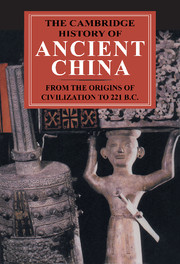Book contents
- Frontmatter
- Introduction
- 1 China on the Eve of the Historical Period
- 2 Language and Writing
- 3 Shang Archaeology
- 4 The Shang: China’s First Historical Dynasty
- 5 Western Zhou History
- 6 Western Zhou Archaeology
- 7 The Waning of the Bronze Age: Material Culture and Social Developments, 770–481 B.C.
- 8 The Spring and Autumn Period
- 9 Warring States Political History
- 10 The Art and Architecture of the Warring States Period
- 11 The Classical Philosophical Writings
- 12 Warring States Natural Philosophy and Occult Thought
- 13 The Northern Frontier in Pre–Imperial China
- 14 The Heritage Left to the Empires
- Bibliography
- Index
- Map 1 Topography of China
- Map 3.1 Archaeological sites of the Early Bronze Age
- Map 6.1 Archaeological sites of the Western Zhou period
- References
2 - Language and Writing
Published online by Cambridge University Press: 28 March 2008
- Frontmatter
- Introduction
- 1 China on the Eve of the Historical Period
- 2 Language and Writing
- 3 Shang Archaeology
- 4 The Shang: China’s First Historical Dynasty
- 5 Western Zhou History
- 6 Western Zhou Archaeology
- 7 The Waning of the Bronze Age: Material Culture and Social Developments, 770–481 B.C.
- 8 The Spring and Autumn Period
- 9 Warring States Political History
- 10 The Art and Architecture of the Warring States Period
- 11 The Classical Philosophical Writings
- 12 Warring States Natural Philosophy and Occult Thought
- 13 The Northern Frontier in Pre–Imperial China
- 14 The Heritage Left to the Empires
- Bibliography
- Index
- Map 1 Topography of China
- Map 3.1 Archaeological sites of the Early Bronze Age
- Map 6.1 Archaeological sites of the Western Zhou period
- References
Summary
No one needs to be persuaded that language plays a fundamental part in any society’s everyday activities and constitutes one of the most durable fibers in the tapestry of human history. Indeed, language is a defining feature of our species. The present chapter describes the structure, history, and setting of the Chinese language, as well as the first appearance and subsequent development of its script, over the millennium from 1200 B.C., the time of the earliest known written record of Chinese, down to the beginning of the imperial era, ca. 200 B.C. While this is primarily a linguistically slanted presentation, it is important to remain aware of the extent to which language history is intertwined with fundamental issues of cultural history in general. The historian may see in language history a rich record of the lives of real people played out in a real world setting and may find clues even to a people’s prehistory. These kinds of broad historical considerations depend on the narrower work of the linguist.
For the linguist, language history is the sum of a painstakingly assembled collection of internal analyses of speech forms and phonetic formulas. The historical linguist is concerned with the evolution of sounds, words, and structures of language, and with linguistic affinities per se. The fact that the linguist’s work is accomplished with little reference to the associated nonlinguistic culture enables the linguist to make an especially valuable contribution to the overall historical study of a people by providing a body of evidence largely independent of the historian’s other sources.
- Type
- Chapter
- Information
- The Cambridge History of Ancient ChinaFrom the Origins of Civilization to 221 BC, pp. 74 - 123Publisher: Cambridge University PressPrint publication year: 1999
References
- 12
- Cited by

